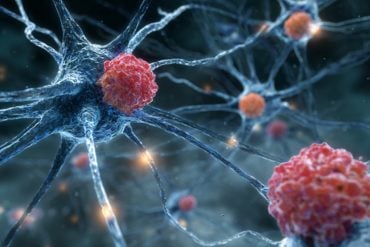Summary: Researchers discovered a small molecule, microRNA-132, might play a significant role in Alzheimer’s disease.
In Alzheimer’s patients, levels of microRNA-132 are often disrupted and notably decreased. While it was known that microRNA-132 had various functions in neurons, this study surprisingly reveals its role in microglia, the brain’s immune cells.
The researchers believe this discovery could open a new avenue in the understanding and potential treatment of Alzheimer’s disease and other neurodegenerative disorders.
Key Facts:
- MicroRNAs, like microRNA-132, are non-coding RNA molecules, which means they do not encode for proteins. However, they can bind to RNA and influence the expression of genes and proteins, playing critical roles in various biological processes and diseases.
- Studies in mouse models have previously indicated that increasing levels of microRNA-132 resulted in the generation of new brain cells and improved memory, highlighting its potential therapeutic value in neurodegenerative diseases like Alzheimer’s.
- Alzheimer’s disease is traditionally associated with abnormal amounts of two proteins: amyloid beta and tau. However, this research suggests that non-coding RNA molecules like microRNA-132, which impact both neurons and microglia, might also be key players in the progression of the disease.
Source: KNAW
A new study from the Netherlands Institute for Neuroscience and the VIB-KU Leuven Center for Brain and Disease Research shows that a very small molecule called microRNA-132 can have a significant impact on different brain cells and may play a role in Alzheimer’s disease.
RNA is a molecule that, like DNA, consists of a series of linked building blocks. RNA was long thought to only serve as a messenger and copy of DNA, enabling the translation of DNA into proteins. However, there are also pieces of RNA that do not encode for proteins.
MicroRNAs are an example of these non-coding RNA molecules. Despite being small in size, they can have a major function: they can bind to RNA and thereby influence the expression of genes and proteins. In many different diseases, including Alzheimer’s, microRNAs are often dysregulated.

Alzheimer’s patients often exhibit disrupted and altered microRNA profiles, particularly a significant decrease in microRNA-132. But does this molecule truly play a role in the disease, or is this decrease merely coincidental?
Previous studies in mouse models have shown that increasing levels of microRNA-132 resulted in the generation of new brain cells and improved memory in the mice. While many researchers believe that the protein amyloid is the primary cause of Alzheimer’s disease, another protein called tau and inflammation also appear to play important roles.
MicroRNA-132 has shown a positive effect on both amyloid and tau pathologies in mice. However, the exact mechanisms are still unknown.
Effect of microRNA-132 in different cell types
Researchers Hannah Walgrave, Amber Penning, Sarah Snoeck, Giorgia Tosoni, and their team, led by Evgenia Salta (in collaboration with the group of Bart De strooper at KU Leuven-VIB, Belgium) investigated the effects of microRNA-132 in different cell types.
They manipulated the levels of microRNA-132 in a mouse model by both increasing and decreasing them. Subsequently, they used a special technique called single-cell RNA sequencing to examine the genes that changed in each cell type in the brain.
Amber Penning: “A microRNA can have numerous targets, which makes them interesting for diseases with multiple pathological aspects. However, this also makes them challenging to study because how do you find those targets?
We know that microRNA-132 performs various functions in neurons, but surprisingly, we found that this microRNA also plays a role in microglia, the immune cells of the brain. This is interesting in the case of Alzheimer’s because we believe that neuroinflammation plays a significant role.”
Changes in cell state
“When we increase microRNA-132 in these microglia, we observe a shift from a disease-associated state to a more balanced homeostatic state. We see this result in both mouse brain and human cell lines. However, whether this change is positive or negative requires further investigation through follow-up experiments.
“There are different theories suggesting that this disease-associated state may initially aid in cell clearance during the early stages of the disease but becomes excessive later, leading to the death of healthy cells. We still need to determine how beneficial it is for the cells to become more homeostatic. Therefore, we need to be cautious in drawing conclusions.”
“The most significant aspect of this study is demonstrating that microRNA-132 also plays a role in microglia and can influence neuroinflammation. The next step is to examine whether increasing microRNA-132 in neurons and microglia in an Alzheimer’s mouse model has any actual effect.
“The same applies to the human cell lines we used. In this research, we only used a healthy control cell line, but we will conduct further tests in Alzheimer’s cell lines to see if there are any effects.”
Ultimate goal
“The ultimate goal would be to increase microRNA-132 in Alzheimer’s patients as a therapeutic strategy. Currently, we are using viruses (containing the microRNA) in Alzheimer’s mice that can be injected intravenously, directly into the veins.
“This makes it easier to eventually translate this strategy to the clinic, as we are utilizing a virus that, in theory, can also be injected into an arm.
“In addition to Alzheimer’s, there are other neurodegenerative diseases that exhibit a decrease in the same microRNA. Therefore, these results may also be relevant to other disease conditions.”
About this genetics and Alzheimer’s disease research news
Author: Eline Feenstra
Source: KNAW
Contact: Eline Feenstra – KNAW
Image: The image is credited to Neuroscience News
Original Research: Open access.
“microRNA-132 regulates gene expression programs involved in microglial homeostasis” by Evgenia Salta et al. Science
Abstract
microRNA-132 regulates gene expression programs involved in microglial homeostasis
Highlights
- MiR-132 is downregulated in Alzheimer’s disease (AD) brain
- Mir-132, mainly known for neuronal functions, regulates many aspects of AD pathology
- MiR-132 manipulation in mouse hippocampus reveals a role in microglial homeostasis
- MiR-132 shifts disease-associated to homeostatic microglia in iPSC-derived cultures
Summary
microRNA-132 (miR-132), a known neuronal regulator, is one of the most robustly downregulated microRNAs (miRNAs) in the brain of Alzheimer’s disease (AD) patients. Increasing miR-132 in AD mouse brain ameliorates amyloid and Tau pathologies, and also restores adult hippocampal neurogenesis and memory deficits.
However, the functional pleiotropy of miRNAs requires in-depth analysis of the effects of miR-132 supplementation before it can be moved forward for AD therapy.
We employ here miR-132 loss- and gain-of-function approaches using single-cell transcriptomics, proteomics, and in silico AGO-CLIP datasets to identify molecular pathways targeted by miR-132 in mouse hippocampus.
We find that miR-132 modulation significantly affects the transition of microglia from a disease-associated to a homeostatic cell state. We confirm the regulatory role of miR-132 in shifting microglial cell states using human microglial cultures derived from induced pluripotent stem cells.






